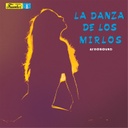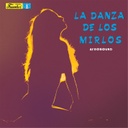TRACKLIST
Side A
1. CALIVENTURA
2. EN LA ESPESURA DEL MONTE
3. EL FORASTERO
4. CHORRILLO
5. ESPERANDO POR TI
6. LA CANCION DEL VIAJERO
Side B
1. SABOR NAVIDEÑO
2. LA DANZA DE LOR MIRLOS
3. RÍO MAGDALENA
4. CACHUCHA BACANA
5. CABEZA DE CHORLITO
6. LA SIRENA
DESCRIPTION
Afrosound’s mission was to emulate the guitar-heavy tropical sounds emanating from Perú and Ecuador at the time. To add to the hippie vibe, there were plenty of whacky improvised vocal asides (called ‘inspiraciones’), plus custom fuzz, wah-wah, flange and echo effects boxes for the guitar and keyboards. A barrage of odd sounding synths, drum machines and other electronic flourishes were also sprinkled in to spice up the proceedings.
The dozen tracks on Afrosound’s debut long play make for a surprisingly diverse palette from which these Colombian musicians painted their daring portrait of Peruvian cumbia, returning the favor in bold colors that still resonate almost 50 years later.
“La danza de los mirlos” kicks off with most famous Afrosound hit of all, ‘Caliventura’, a genius blend of funk and cumbia. Also, there are several covers including various Colombian costeño classics, a groove oriented son montuno / cumbia hybrid, Fruko’s bomba-funk ditty ‘El chorrillo’, the melancholic psychedelic cumbia ‘Esperando por ti’ and the rocking cumbia andina gem ‘Cabeza de chorlito’.
This lovingly restored reissue features the artwork for the Peruvian edition, which was licensed and issued by Lima’s El Virrey label in 1974.
Afrosound was born from the desire of Discos Fuentes vice-president José María Fuentes to come up with a domestic version of the emerging African and Latin rock sounds coming from outside the country, inspired by groups like Osibisa and Santana. The mission was to emulate the guitar-heavy tropical sounds emanating from Perú and Ecuador at the time. According to various sources, the 1972 tune ‘La danza de los mirlos’ (by Peru’s Los Mirlos) emerged as a great success in Colombia and with it a new way of interpreting the country’s most famous musical export, namely cumbia, through a Peruvian perspective. Fuentes executives convened an expert crew of musicians the following year to create this type of music for the domestic market because they sensed a potential for similar success.
Afrosound would cover not only ‘La danza de los mirlos’ and name their debut LP after the song in 1973, but they would also faithfully reproduce the unique sound of their guitar hero Enrique Delgado. The first Afrosound recordings were made with a fantastic rhythm section consisting of talented musicians that had played with Fruko y sus Tesos. Initially the vocals, when there were any, were handled by Wilson “Saoko” Manyoma, Joe Arroyo or Jaime Ley under the direction and musical arrangements of Julio Ernesto “Fruko” Estrada, who also played bass and composed several numbers. To add to the hippie vibe, there were plenty of whacky improvised vocal asides (called ‘inspiraciones’), plus custom fuzz, wah-wah, flange and echo effects boxes for the guitar and keyboards. A barrage of odd sounding synths, drum machines and other electronic flourishes were sprinkled in to spice up the proceedings, providing a competitive edge that made the Fuentes sound so unique.
“La danza de los mirlos” kicks off with most famous Afrosound hit of all, ‘Caliventura’, a genius blend of funk and cumbia. Aside from the cumbia amazónica title tune, there are several other covers including three popular songs by Nelson y Sus Estrellas, plus radically reimagined versions of various Colombian costeño classics published by
Fuentes. Mario “Pachanga” provides a sad but still groove-oriented Christmas son montuno / cumbia hybrid while Fruko brings us the bomba-funk ditty ‘El chorrillo’ and the rocking cumbia andina gem ‘Cabeza de chorlito’ where Sepúlveda channels Enrique Delgado. Fruko collaborator Hernán “Hercovalle” Colorado Vallejo rounds things out with the melancholic psychedelic cumbia ‘Esperando por ti’, proving that every tropical party has to have its down side as well.
All in all, the dozen tracks on Afrosound’s debut long play make for a surprisingly diverse palette from which these Colombian musicians painted their daring portrait of Peruvian cumbia, returning the favor in bold colors that still resonate almost 50 years later.
Naturally, like all homegrown purpose-built groups at the label, Afrosound soon veered from its course and created its own hybrid of sounds that really came from all over and nowhere at once, much of it done with a sense of originality and experimental psychedelic playfulness.
Despite the original philosophy with which Afrosound was created (and is in fine form on ‘La danza de los mirlos’), mainly to explore the Amazonian and Andean instrumental sounds of Peru, the group was always focused on the taste of their audience, so eventually they interrupted their initial tendencies towards recording only instrumentals
in order to start adding tracks with lead vocals and fuller lyrics, which in turn led to a more relatable repertoire for listeners that brought future triumphs, especially during the holidays.
The records were also released in the US, Ecuador, Perú, Panamá, Mexico and Venezuela, and probably had an influence of their own, at least in South America. In fact, the cover of this lovingly restored reissue features the artwork for the Peruvian edition, which was licensed and issued by Lima’s El Virrey label in 1974. The original Fuentes artwork, with a far more outrageous “cheesecake” image, can be seen on the back cover.


